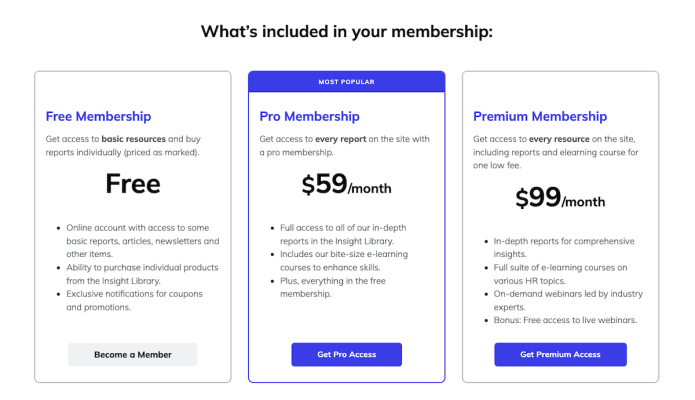
Setting the subscription prices for your membership website is a critical step to ensuring its profitability and long-term sustainability. When deciding the price, it's important to consider various factors, including the value you offer, your target audience and the costs involved. If you set the price too low, your profit margins might erode under the weight of fixed expenses like hosting, development, marketing and content creation. On the other hand, pricing too high could alienate potential subscribers, especially if they perceive your offering as not matching the cost.
How to set your subscription pricing in 2025 for value, retention and growth
1. Optimize your membership pricing strategy
Many website owners set their subscription price based on a guess, but testing is essential. Unlike print publications, online platforms allow easy price adjustments. Experiment with different prices and track the results using A/B testing. Regularly refine your strategy to maximize profits.
To strike the right balance, start by analyzing your target audience and understanding their willingness to pay. Conduct market research to benchmark against competitors in your niche. Highlight your unique value proposition and justify your pricing with clear benefits and exclusivity.
Regularly evaluate and adjust your pricing strategy based on feedback, market trends, and your business goals. Testing different price points through limited-time offers or A/B testing can provide insights into what works best.
2. Pricing guidelines
While there are no universal rules, these benchmarks can help:
- Typical Monthly Rates for subscriptions are between $4.95 and $19.95.
- Revenue Example: 1,000 members at $9.99/month = $120,000 annually. After expenses, this could mean $100,000 in profit for a home-based operation.
- Consumer Sites: $50–$200/year.
- Business Sites: $200–$1,120/year.
3. Provide flexible payment options to suit diverse member needs
Consider offering tiered pricing or multiple subscription levels to appeal to a broader audience. A well-structured range of pricing options can significantly boost conversions by accommodating a variety of budgets, preferences and commitment levels. By allowing members to select the plan that best fits their financial situation, you create a more inclusive and flexible user experience.
Encouraging long-term commitments through discounted annual subscriptions not only adds value for your members but also provides your business with more stable and predictable revenue. For example, positioning the annual plan as the most cost-effective option compared to monthly billing can effectively incentivize subscribers to commit for a full year.
While tiered membership levels can be highly effective, it's important to avoid offering too many choices, which can lead to decision fatigue and lower conversion rates. Aim for a balanced structure—typically three to four clearly differentiated tiers—to guide users toward the option that best suits their needs without overwhelming them.
4. Offer promotional deals and free trials
Leveraging special promotions is a powerful way to attract new member sign-ups and reduce hesitation among potential subscribers. Creating a sense of urgency by combining a time-sensitive discount with a clear expiration date can prompt quicker decisions and drive immediate action. Tactics such as limited-time offers, promotional codes, or introductory deals are proven to increase conversions, especially among first-time visitors.
To enhance the appeal, consider bundling your promotion with value-added perks like a free course, exclusive webinar access, or bonus content available only to new members. These added incentives not only make the offer more enticing but also reinforce the perceived value of joining.
Strategic promotions allow you to engage price-sensitive audiences without devaluing your regular pricing structure. Promote your campaigns through targeted email marketing and social media channels, ensuring your message reaches the right audience
5. Create content tailored for your members
The exclusivity and uniqueness of your content directly influence how much you can charge for your membership website. High-value content that cannot be easily found elsewhere, such as specialized advice, insider information, or industry-specific insights, justifies premium pricing because it solves a specific problem or meets a niche need for your audience. For instance, expert strategies in stock trading, personalized coaching, or access to exclusive research reports can command significantly higher rates due to their perceived value and impact.
To establish pricing that is both competitive and profitable, conduct in-depth research into how similar platforms are priced. Understanding your competitors’ offerings and emphasizing your unique value proposition are key to setting a price that resonates with your audience while reflecting the exclusivity of your content.
6. Payment providers and compliance
Choosing the right payment processor is an important decision for your membership website, as it directly affects user experience, payment reliability and revenue management. Look for a processor that supports recurring payments to ensure seamless subscription renewals and minimises churn due to payment failures. Ensure the platform is secure, complies with industry standards and offers fraud protection to safeguard your members’ data.
Consider its compatibility with your website platform, the ease of integration and whether it provides flexible payment options such as credit cards, digital wallets and international currencies to accommodate a global audience. Additionally, pay attention to transaction fees, payout schedules and customer support to ensure the processor aligns with your budget and operational needs.
Conclusion
Your subscription pricing should be dynamic and data-driven. Test continuously, understand your audience, and refine your strategy to strike the perfect balance between value and profitability.




